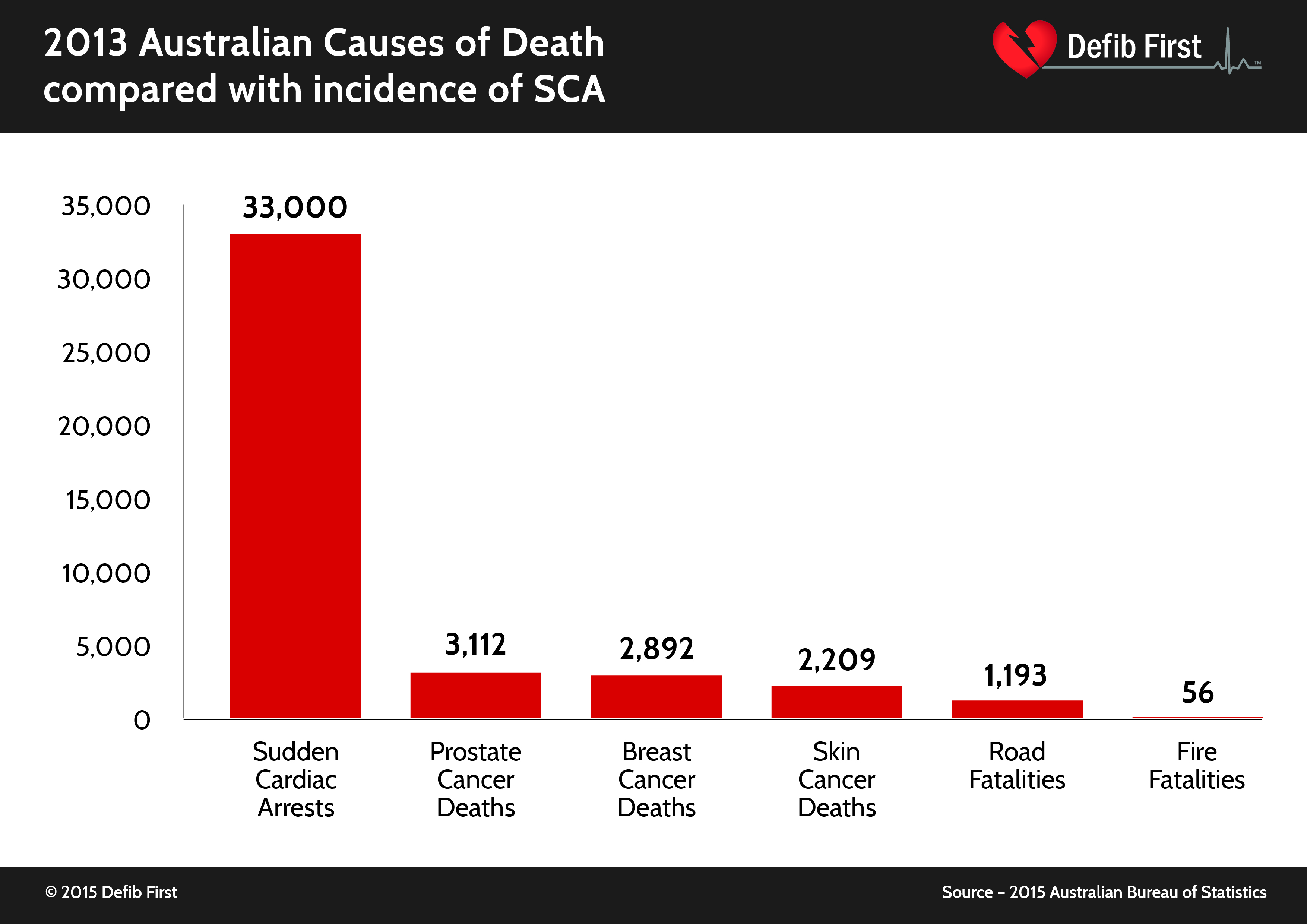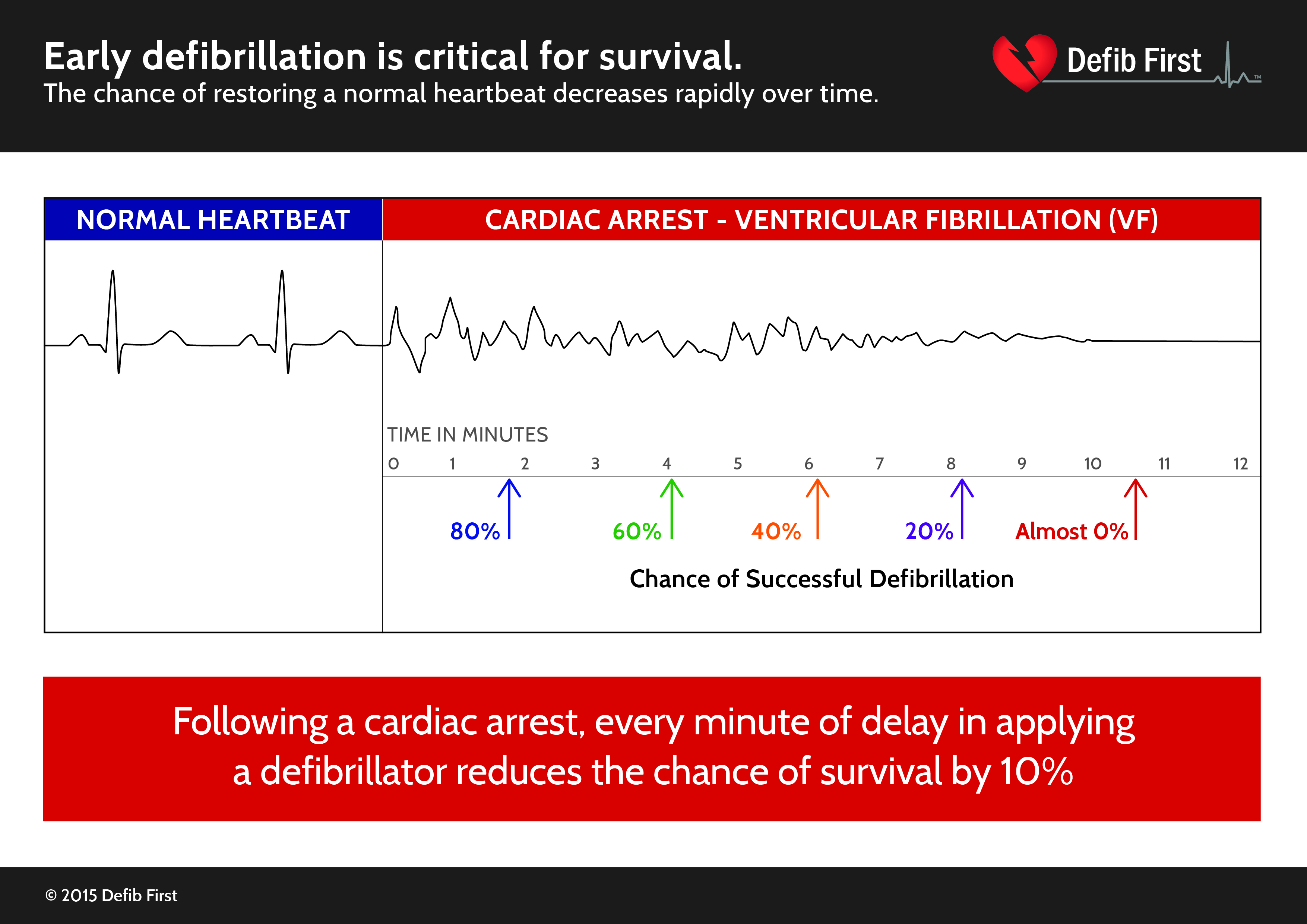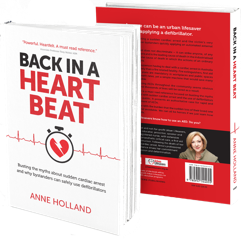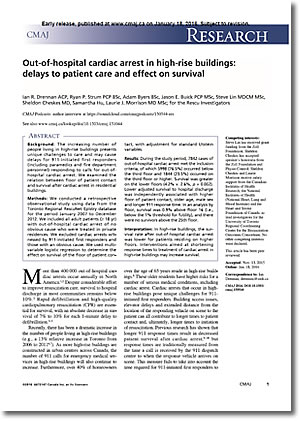Defib First Blog
Out of hospital cardiac arrest in high-rise buildings
More than 400 00 out-of-hospital cardiac arrests occur annually ion North America. Despite considereable effort to improve resuscitation care, survival to hospotal discharge in most communities remains below 10%. Rapid defibrillation and high-quality cardiopulmonary resuscitation (CPR) are essential for survival, with an absolute decrease in survival of 7% to 10% for each 1-minute delay to defibillation
Sleeping giant of risk and liability for employers
Safety is increasingly becoming a core value in corporate mission statements. There is a duty of care incumbent upon employers and government agencies to provide the safest environment possible for their employees and customers. Large organisations (private and government) can have hundreds and even thousands of members of the general public entering their premises every day.
Changes in 2014 to Australian first aid training regulations, which now require competency in the use of an automated external defibrillator (AED) by first aid trained staff, have created greater exposure to adverse risk and liability for employers.
Changes to first aid training requirements
First aid training is a series of regulated units of competency within the Health Training Package (HLT) which is governed by the Community Services and Health Industry Skills Council and is regulated under the auspices of the Australian Government.
Until 2013 in Australia, an employer with 10 or more employees was required to provide first aid trained personnel who were competent in performing CPR until paramedics arrived and took over. At that time, the regulations for the first aid unit of competency ‘HLTCPR211A – Perform CPR’ required the training participant to ‘have an understanding’ of what an AED was and how it worked. The unit of competency did not include mandatory training and assessment in the application of an AED during a cardiac arrest nor did an AED need to be available during training for participants to observe how it worked.
On July 1 2013, the Australian Resuscitation Council guidelines for first aid training were superseded and revised key competencies were introduced. The CPR unit of competency was amended and renamed ‘HLTAID001 – Provide cardiopulmonary resuscitation’ with a new key element that requires training participants to be assessed and deemed competent in not only the performance of effective CPR but also in the application of an AED.
The new guidelines came into force on 1 July 2014, and all first aid personnel are required to update their competency in that unit each year.
Implications for business
Although the Australian Government now requires that first aid personnel achieve competency in defibrillation, state and territory governments have not legislated that AEDs be mandatory inclusions in first aid kits.
The argument could be made that AEDs should be an essential inclusion in first aid kits in the workplace because if a medical emergency incident occurred that required the use of a defibrillator for the first aid management of the casualty, the first aid officers could not perform the lifesaving skills for which they had been trained, if the device that enables those skills was not available.
Is there a potential for the organisation (public or private) to be held liable and to be sued if a casualty dies because first aid officers are trained to use an AED but a defibrillator is not available and so they cannot provide the most effective resuscitation treatment for a cardiac arrest?
Liability risks
Across the community, and particularly in the workplace, there is significant misunderstanding of sudden cardiac arrest: what it is, who it affects, and the role of defibrillation in saving the life of the casualty.
There is a common and erroneous perception that businesses are more unsafe or at a greater liability risk by having an AED on the premises when, in fact, the liability is more likely to be decreased and safety enhanced by providing this life saving device.
While a successful liability lawsuit for not having an AED may seem unlikely under current Australian OH&S laws, people (both employees and customers) have a far greater awareness than ever before of their rights in the workplace, and businesses that do not move with the changes in training regulations are potentially vulnerable.
Modern AEDs cannot be used inappropriately and it is not possible to do any further harm to a cardiac arrest victim who is, in effect, dead and will remain so unless defibrillated.
An AED is the most vital piece of emergency first aid equipment and the only effective first aid treatment for cardiac arrest. Therefore, having an AED in the workplace increases safety and peace of mind and decreases workplace risk and liability.
Is failure to provide an AED comparable with a failure to have fire extinguishers on site as a safety precaution in case a fire breaks out? Failure to provide a fire extinguisher and evacuation plan would be a breach of occupational health and safety/workplace health and safety (OH&S/WHS) laws and the employer would be liable. Shouldn’t the same onus of responsibility apply to providing an AED which is the only definitive treatment for sudden cardiac arrest (SCA)?
Having fire prevention equipment on site is a form of insurance and does not mean that a workplace is more likely to have a fire, thereby making the workplace unsafe. AEDs should have the same status as fire extinguishers and smoke detector alarms for the prevention and management of adverse events.
In an article, ‘Learn how to use defibrillator and save lives’, published in The Edinburgh Evening News on 30 July 2014, Paris Gourtsoyannis described how:
Without really noticing it, every day we’re surrounded by kits that can help keep us safe if the worst should happen. Burn your toast in the morning, and it will probably set off the smoke alarm. At your office or workplace, you’re never far from the nearest fire extinguisher, and you may have a designated first-aider or fire warden. You probably know where the first aid kit is at home, even if it’s at the back of the drawer, and you may have a carbon monoxide detector, too. But what about a device that could save your life if you had a heart attack [cardiac arrest]?
While fire extinguishers are required everywhere, most paramedics and firefighters will tell you they've used an AED far more often than a fire extinguisher.

Modern fire protection policies have reduced fire/smoke related fatalities in Australia in 2013 to 56 deaths. With 33,000 cardiac arrests in Australia each year, it is 590 times more likely that a layperson will be confronted with a cardiac arrest emergency than a fire fatality. Without early defibrillation, less than 5% of cardiac arrest victims will survive resulting in thousands of preventable deaths.
Duty of Care & Heart Safe workplaces
Businesses need to consider the duty of care implications when employers do not provide the very piece of equipment which they have trained their staff to use and which could actually save a life if someone had a cardiac arrest on the premises.
Businesses should also consider how the changes in first aid training regulations affect safety, risk, liability, governance and compliance for the employer and government agencies, not just for staff but also for customers and clients on their premises.
Many workplaces have ensured that their environment is ‘Heart Safe’ by voluntarily installing AEDs and educating their staff as to where to find them as well as why, when and how to use them; however, there is still significant resistance from employers to providing these lifesaving devices.
Cost of employee death, illness or injury from sudden cardiac arrest
When an employee dies or suffers serious illness or injury, there is significant loss to industry in terms of lost time injury, productivity, replacement and training of personnel, sick-leave and termination payouts and, potentially, liability and compliance costs. The unexpected death of a colleague at work also results in serious psychological and emotional shock for other staff, which imposes additional burden on the business.
According to the Australian Bureau of Statistics (ABS), 11.6 million people in Australia are in employment, and the majority of the population, both employed and unemployed, use retail, government, health, educational and sporting services.
The ABS estimates that the years of potential life lost (YPLL) from cardiac causes of death in Australia is more than 110,000 years. Having an AED in the workplace or available in the community could save thousands of lives.
In December 2014, Ambulance Victoria released the Victorian Ambulance Cardiac Arrest Registry annual report 2013–2014. In a follow-up of survivors to assess their quality of life 12 months after a cardiac arrest, VACAR reported that 84% of those who survived to be discharged from hospital – after being defibrillated and revived within minutes of collapse by bystanders – returned to a normal productive life. In comparison, without early defibrillation less than 5% of victims even survive cardiac arrest, let alone return to normal life and activities.
The American Heart Association journal, Circulation, reported in November 2014 that in the United States, out-of-hospital cardiac arrest (OHCA) creates a huge burden on public health. Many of the victims are still in their productive years with approximately 350,000 OHCA deaths occurring each year and similar numbers in Europe. The impact of the financial burden on society is estimated at US$33 billion per year in the United States alone.
Apart from the costs of emergency response systems, for those who survive to reach hospital, there is a significant drain on resources with the additional costs of critical and intensive care, diagnostic tests and investigations and hospitalisation. For victims, who survive to be discharged from hospital, there are the costs of long-term care including rehabilitation, medical devices such as implantable cardioverter-defibrillators, disability expenses, and ongoing medical management.
If an employee dies from a cardiac arrest, the business will face potentially avoidable costs to replace them, to train new staff and lost productivity during the time the position is vacant.
Not all victims of SCA die – some will recover but the length of recovery time and the extent to which they resume normal life activities is directly affected by how long it takes for defibrillation to take place. Therefore, what might it cost if a staff member suffers cardiac arrest and is off sick, or can only return to limited duties, or is unable to return to work at all?
Attitudes to AEDs
Education programs are needed to uncover the truths and facts about AEDs and to dispel people’s fears. Busting those myths and misunderstandings through education is the only way to encourage more people, regardless of whether they have first aid training, to ‘have a go’ and apply an AED without hesitation.
Early defibrillation is the most vital link in the ‘Chain of Survival’. The application of an AED within the first five minutes after cardiac arrest gives the victim the greatest likelihood of surviving and making a full, long-term recovery, that is, the victim returns to work and resumes normal life activities.

After eight minutes without defibrillation, the likelihood of survival with a full recovery is rare. Having a defibrillator readily available, in most cases, means the difference between life and death.
It is a sobering thought that large workplaces are increasingly occupying multi-storey buildings that are becoming higher and higher, yet in a recent study published by the Canadian Medical Association, it has been shown that the higher the floor of a building, the lower the likelihood of survival, due to the time delay in emergency services reaching the casualty. Application of an AED by bystanders is the single most important determinant of survival in these circumstances.
For rapid accessibility, there is an obvious and rational argument for the inclusion of AEDs in all elevators of high rise buildings.
Purchase price
Businesses spend extraordinary amounts of money on technology, research and development, CCTV, security systems, fire equipment, evacuation drills and training to protect staff and property.
Perceptions about cost often create resistance to purchasing an AED. In Australia, the cost of a quality AED ranges between $2,000 and $3,000. AEDs have seven- to -10-year warranties, and come with long-life non-rechargeable batteries that last several years. The purchase price amortised over a conservative 10-year life of the device equates to only $200–$300 per year compared with the potential cost of a life lost. The increase in safety awareness and compliance and the reduction in liability should be a worthy and reasonable trade-off for the modest cost.
Two to three hundred dollars per year is not an excessive outlay compared with the significant loss to industry in relation to safety, productivity, lost time injury, replacing and training personnel, termination/sick-leave payouts, life insurance payments and, potentially, liability and compliance costs. Not to forget the potential for a civil liability law suit.
Heart Safe Workplaces
With growing public awareness, the risk of potential liability resulting from not having an AED is becoming more likely. Support for deployment of lifesaving AEDs, however, is gaining momentum across Australia and, particularly, the rest of the world.
The value proposition of investment in a Heart Safe Workplace, combined with community participation in resuscitation, is a powerful motivator for widespread accessibility to AEDs which will result in thousands of lives saved.
More information on the role of AEDs in saving lives can be found in Anne Holland’s book 'Back in a Heart Beat' or on website www.defibfirst.com.au. All proceeds from the book sales are donated to not-for-profit Urban Lifesavers.

Declare war on cardiac arrest

Anne Holland 5 November 2015
In 1969 there were 1034 road fatalities in Victoria which prompted Victoria Police to ‘Declare War on 1034’ with the objective of reducing the road toll.
Australia led the world in the introduction of seat belts. New legislation enabled a crackdown on speeding and drink driving and more recently drug affected driving. Road conditions and vehicles were improved. Learner driver requirements were tightened. Governments spent millions of dollars on road safety messages and driver education. Public awareness campaigns have been prominent and ongoing.
The effectiveness of funding, law enforcement and increased awareness has lowered the road toll in Victoria to 249 in 2014 – a 75% reduction in deaths over more than 45 years.
Each year in Australia, it is estimated that there are 33,000 sudden cardiac arrests (6000 in Victoria), with 75% or approximately 25,000 occurring outside of a hospital. Cardiac arrest is the one cause of death that relies on the bystander witness i.e. the person standing next to the victim to take action to save their life. Without early CPR and most importantly early defibrillation, less than 5% of cardiac arrest victims survive. If an automated external defibrillator (AED) is applied within 3-5 minutes to a victim of cardiac arrest, their chance of survival increases to over 80%. For every minute of delay, the likelihood of survival decreases by 10%.
The problem is there are too few AEDs in the workplace and community and too few people who know why or how to use them. Cardiac arrest is reversible if there is immediate action and yet there is no funding, legislation, education or public awareness campaigns to address this significant public health issue.
The road fatality strategies have been successful and thankfully many lives have been saved. There is the potential, however, to save as many lives in one year from cardiac arrest as has been saved in 45 years from road trauma.
This is not an argument against road safety campaigns. They are necessary and have worked. It is an argument however to pay more attention to the leading cause of death in this country especially when the solution is so simple and easy to use.
AEDs save lives – they are safe, reliable, effective and cannot be used inappropriately. They cannot shock the wrong person or someone that does not need defibrillation. Rescuers cannot kill someone who is in cardiac arrest or be held liable or sued for applying an AED because the victim is already dead. Any attempt at resuscitation is better than no attempt. Everyone in the community can become an urban lifesaver if they are educated on why and how to use an AED.
Fire extinguishers and smoke detector alarms are compulsory and regular testing and tagging of fire equipment is mandated. As a result of fire protection regulation, there were only 56 fire or smoke related deaths recorded in Australia in 2013. Once again, legislation, education and awareness have dramatically reduced fatalities.
Comparing cardiac arrest with fire/smoke fatalities, it is 590 times more likely that a member of the public will have to deal with a cardiac arrest than a death by fire.
It is time greater focus is placed on reducing cardiac arrest fatalities with increased funding, public awareness campaigns, widespread availability of AEDs and community education.
We now need to Declare War on Cardiac Arrest and thousands of lives will be saved as a result.




